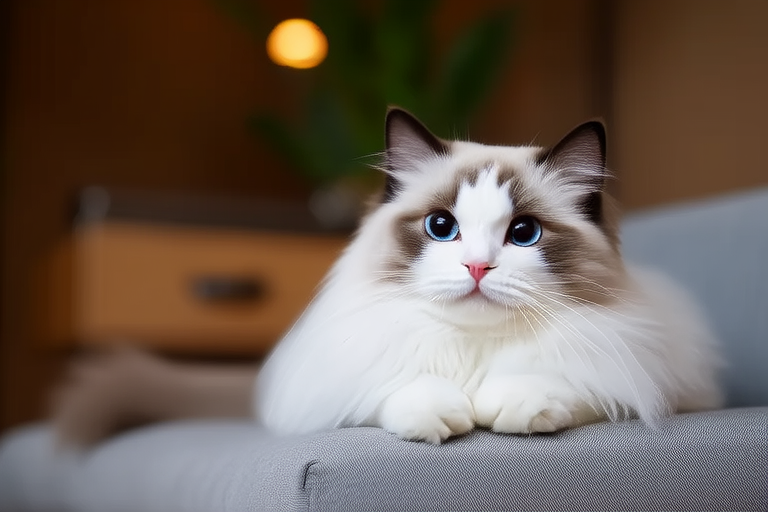Secrets of the Ragdoll: Tips for Raising One of the Most Affectionate Cats
The Ragdoll is one of the most beloved cat breeds, renowned for its gentle and affectionate nature. This guide aims to provide comprehensive advice for raising a Ragdoll, covering everything from their personality traits to health considerations and bonding activities.
Ragdoll Cat Personality Traits
Ragdolls are known for their docile and friendly demeanor, making them excellent companions. They often follow their owners around the house like loyal dogs, seeking attention and interaction. Dr. Jane Smith, a veterinarian specializing in feline behavior, notes, “Ragdolls have a unique ability to bond deeply with their human families, often showing more affection than many other breeds.”
Anecdotes from owners highlight this trait. Sarah Johnson, a long-time Ragdoll owner, shares, “My Ragdoll, Luna, loves to sit with me while I read or watch TV. She even curls up next to me when I sleep.” Their affectionate nature means they thrive on human company and can become attached to their owners, sometimes to the point of separation anxiety if left alone for extended periods.
Ideal Living Conditions
Ragdolls prefer calm and quiet environments where they can relax and enjoy their surroundings. While they adapt well to apartment living, they need sufficient space to explore and play. Providing vertical spaces such as cat trees and window perches allows them to observe their environment from above, which satisfies their natural curiosity.
Environmental enrichment is crucial for Ragdolls. Interactive toys, puzzle feeders, and scratching posts help stimulate their minds and keep them entertained. Regular play sessions are essential, as these cats enjoy mental and physical challenges. Owners should ensure their living spaces are safe and free from hazards like toxic plants and small objects that could be swallowed.
Dietary Needs
A balanced diet is vital for maintaining a Ragdoll’s health and energy levels. High-quality cat food rich in proteins and fats supports muscle development and coat health. Ragdolls may benefit from foods specifically formulated for indoor cats, as they tend to be less active. Owners should consult their veterinarians about appropriate diets based on their cat’s age, weight, and activity level.
Hydration is equally important. Fresh water should always be available, and some owners find that adding water fountains encourages their cats to drink more. Obesity is a common issue among Ragdolls, so portion control and regular exercise are necessary to prevent excess weight gain.
Grooming Routines
Ragdolls have semi-longhair coats that require regular grooming to prevent matting and hairballs. Brushing at least twice a week helps distribute natural oils throughout the fur, keeping it shiny and healthy. Bathing should be done sparingly, as Ragdolls generally dislike water. However, occasional baths can help remove dirt and debris.
Maintenance of oral hygiene is also crucial. Daily tooth brushing using pet-safe toothpaste can prevent dental issues. Owners should check their Ragdoll’s ears weekly for signs of infection or wax buildup and clean them gently if necessary. Nails should be trimmed every few weeks to avoid overgrowth and potential injury.
Health Considerations
Ragdolls are generally healthy but may be prone to certain genetic conditions. Hypertrophic cardiomyopathy (HCM) is a heart disease that can affect Ragdolls, particularly those with blue eyes. Regular veterinary check-ups, including heart screenings, are recommended. Responsible breeders screen for HCM before breeding to reduce the risk.
Feline lower urinary tract disease (FLUTD) is another concern, especially for indoor cats. Providing access to clean water and promoting frequent urination can help prevent FLUTD. Litter box hygiene is essential; owners should scoop daily and replace litter regularly. Monitoring urine output and consistency can alert owners to potential health issues early.
Training Techniques
Ragdolls are intelligent and trainable, responding well to positive reinforcement methods. Clicker training, treats, and verbal praise can encourage good behaviors. Teaching basic commands like ‘sit’ and ‘stay’ can strengthen the bond between owner and cat. Some owners have successfully trained their Ragdolls to fetch or come when called.
Consistency is key in training. Establishing a routine and rewarding desired behaviors consistently will help reinforce positive habits. Patience is also important, as Ragdolls may take time to learn new tricks or commands. Training sessions should be short and fun, ensuring both the owner and the cat enjoy the process.
Bonding Activities
Engaging in regular activities with your Ragdoll can deepen your connection. Playing fetch, chasing laser pointers, or using interactive toys can provide mental stimulation and physical exercise. Many Ragdolls enjoy being carried or held, and some even tolerate being dressed in cat outfits for special occasions.
Socializing your Ragdoll with other pets and people from an early age can enhance their social skills. Introducing them to various environments and experiences can help build confidence. Regular handling, including petting and brushing, can make grooming sessions more enjoyable for both the owner and the cat.
Conclusion
Raising a Ragdoll is a rewarding experience, offering companionship and joy. By understanding their unique personality traits, providing ideal living conditions, and addressing their dietary, grooming, and health needs, owners can ensure their Ragdoll lives a happy and healthy life. The affectionate nature of Ragdolls makes them wonderful pets, and with proper care, they can bring years of love and companionship to their human families.
